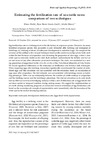Please use this identifier to cite or link to this item:
https://accedacris.ulpgc.es/handle/10553/31723
| Title: | Estimating the fertilization rate of sea turtle nests: Comparison of two techniques | Authors: | Abella Pérez, Elena García Cerdá, Rosa María Marco, Adolfo |
UNESCO Clasification: | 2401 Biología animal (zoología) 240116 Herpetología 240107 Embriología animal |
Keywords: | Embryonic development Fertilization rate Loggerhead turtle Reproduction |
Issue Date: | 2017 | Journal: | Basic and Applied Herpetology | Abstract: | Egg fertilization rate is a defining event in the life history of oviparous species. However, for many terrestrial oviparous species, this parameter is only estimated after hatching and emergence of hatchlings, by studying evidence of embryonic development in unhatched eggs. We compared the accuracy of this method with a second technique based on the careful excavation of sea turtle nests within the first 96 hours of oviposition and calculating the proportion of alive eggs, where a clear white spot is externally visible in the shell. Both methods underestimate the fertility rate but we are not aware of any other alternative on‐invasive technique. The study was conducted in a nest‐ ing population of loggerhead turtles (Care tta care tta) at Boa Vista Island (Republic of Cabo Verde). We found significant differences in the estimation of fertilization rate between both techniques. When inspecting eggs after hatching, researchers significantly overestimated the number of unfer‐ tilized eggs and this calculation was not correlated with the estimation based on examination of eggs soon after oviposition. The first estimate was not correlated with hatching success or hatch‐ ling phenotype. There was no relationship between the number of viable embryos at oviposition and the hatching success and the hatchling’s phenotype. The absence of embryo or its early death had no effect on survival of developing embryos within a nest. Fertilization rate in loggerheads did not show spatial or temporal variation during nesting season. We suggest the implementation in sea turtle nesting monitoring programs of annual less‐invasive estimation of egg fertilization rate based on the excavation of a sample of representative nests immediately after the formation of the white spot in the shell of developing embryos. | URI: | https://accedacris.ulpgc.es/handle/10553/31723 | ISSN: | 2255-1468 | DOI: | 10.11160/bah.57 | Source: | Basic and Applied Herpetology [ ISSN 2255-1468], v. 31, p. 33-44 | URL: | http://api.elsevier.com/content/abstract/scopus_id/85036534818 |
| Appears in Collections: | Artículos |
SCOPUSTM
Citations
11
checked on Mar 30, 2025
Page view(s)
73
checked on Dec 21, 2024
Download(s)
119
checked on Dec 21, 2024
Google ScholarTM
Check
Altmetric
Share
Export metadata
Items in accedaCRIS are protected by copyright, with all rights reserved, unless otherwise indicated.
